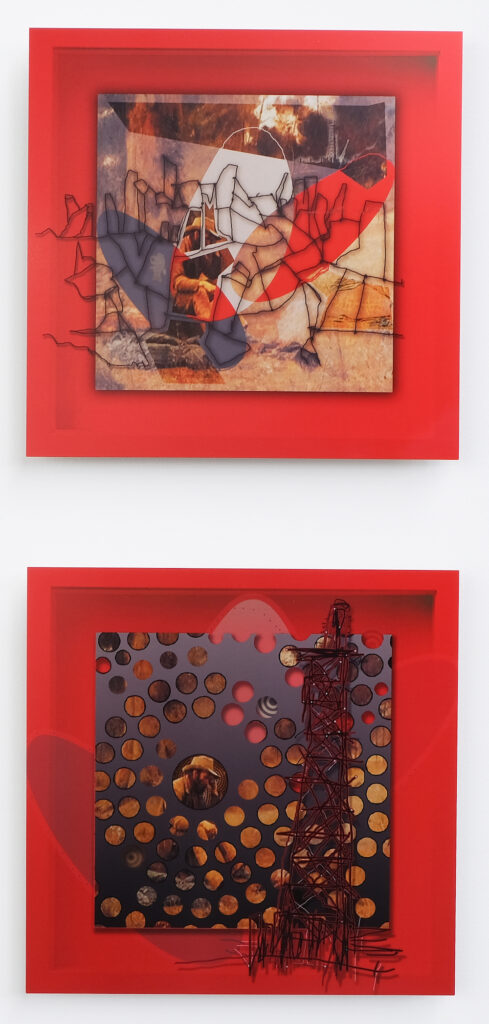Cataloguing the beauty of Murujuga’s ancient landscape and the damage inflicted on this Country by industrial behemoths, this exhibition is a searing critique of those corporations and the governments that support them, writes Zali Morgan.
A powerful call to protect Murujuga
2 August 2023
- Reading time • 7 minutesVisual Art
More like this
- Waves of influence span an ocean
- A walk with Tina Stefanou
- A blaze of glorious people
Murujuga: celebration of an ancient cultural landscape, various artists
Holmes à Court Gallery @ no.10
Protesting against the “largest industrial hub in the Southern Hemisphere”1, Murujuga: celebration of an ancient cultural landscape is an exhibition that brings together more than 40 artists and creatives, all standing for one thing – to protect the Burrup.
Located 5km outside of Karratha, the Burrup peninsula – where Murujuga is located – contains the world’s largest, oldest and longest sequence of petroglyphs, including the oldest depictions of the human face. It is also home to the operations of Woodside Petroleum, Rio Tinto and Yara Pilbara. Protests against industrialisation around the Burrup peninsula and the resulting destruction of the area’s precious ancient artefacts have intensified recently, with many seen around Boorloo (Perth).
Murujuga: celebration of an ancient cultural landscape functions an in-depth critique of the actions of industrial giants and the state and federal government in the Burrup. Presented by Holmes à Court Gallery in association with Friends of Australian Rock Art Inc. (FARA), the exhibition features works by First Nations artists from Cheeditha Art Group, Juluwarlu Art Group and Yinjaa-Barni Art, as well as works from non-First Nations artists, all of whom have responded to Murujuga. The exhibition is curated by FARA’s Judith Hugo OAM, with coordinating curator Laetitia Wilson (HAC Gallery).

On entering the Holmes à Court Gallery @ no.10, we encounter Ngarluma artist Jill Churnside’s vibrant painting, Burrup Guardians alongside Boorloo-based artist and FARA member Susan Swain’s pastel drawings Murujuga Cathedral and The Sentinel, a pleasing trio that gives us a taste of what’s to come.
However, this act of togetherness is short-lived, with the majority of the space divided into two; First Nations work on the left, artworks by non-First Nations artists on the right. This kind of curatorial divide is common when First Nations and non-First Nations works appear together, begging the question: why? It feels unnecessary.
In spite of this division, the exhibition speaks with a clear, strong, unified voice. Murujuga: celebration of an ancient cultural landscape holds space for an astonishingly large number of works, from artists ranging from emerging to established, united in protest about the way industrial behemoths are treating Country.
Juluwarlu Art Group artist and Yindjibarndi Elder Wendy Hubert’s untitled work initially grabbed my eye. Beautifully depicting her country with yellow skies and brave, loose brush strokes, Hubert captures your attention with the passion that goes into caring for Country.
One of the most important works of the exhibition, also from Juluwarlu Art Group, is Yandanyirra [the Fortescue River], a three-panel collaborative piece that depicts the significance of the river for the continuation of culture, and of the rock art in Murujuga.
With the wide, stranded green ribbon of the Yandanyirra flowing continuously through each panel, the works draw upon key components of Yindjibarndi culture and stories. Contributing artists include Courtney McKay, Judith Coppin, Wendy Hubert, Alice Guiness, Margaret Read, Harry Mills, Lorraine Coppin, Hayden Woodley, Sharona Walker, Lilly-Jo McKay, Denna Lockyer, Gabrielle Cheedy and Bella Walker.

Playing with the iconic Frederick McCubbin painting, Down on his luck, Boorloo-based artist David Hummerston draws us straight to the heart of the Murujuga campaign, referencing fellow protestor Joana Partyka’s defacing of McCubbin’s original work at the Art Gallery of Western Australia.
Using digital print on aluminium, Hummerston’s works Pushing our Luck #1 and #2 allow bits of a copy of the McCubbin to peek through overlaid geometric patterns, some perhaps referencing the Woodside logo, encapsulated within a screaming-red background.
Some might say these thought-provoking works are a more conventional deface than Partyka’s. Whilst resolved and contemporary in style, however, Hummerston’s works are some of the more surprising and less conventional works within the exhibition, stepping apart from the many landscapes.
Murujuga: celebration of an ancient cultural landscape is clearly calling for change, and the teams at Holmes à Court Gallery and FARA are behind that call to action. Featuring works from a vast selection of artists, the exhibition serves as an archive of past protest as well as a showcase of artwork drawn from the pain suffered by Country.
This exhibition is a must-see for anyone interested in protecting our Country.
Pictured top: One of the most important works in the exhibition is ‘Yandanyirra (the Fortescue River)’, 2022, 150 x 150 cm (each), by Courtney McKay, Judith Coppin, Wendy Hubert, Alice Guiness, Margaret Read, Harry Mills, Lorraine Coppin, Hayden Woodley, Sharona Walker, Lilly-Jo McKay, Denna Lockyer, Gabrielle Cheedy, Bella Walker,
1. Sir Charles Court, as quoted in the Murjuga: celebration of an ancient cultural landscape exhibition program.
Like what you're reading? Support Seesaw.





